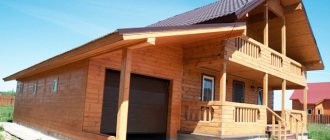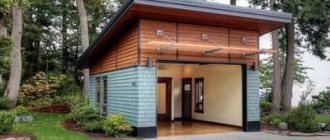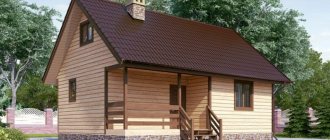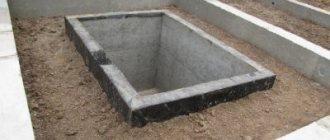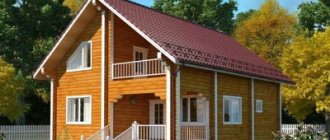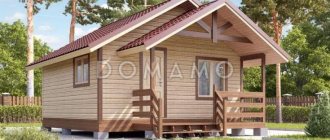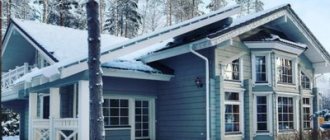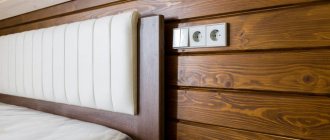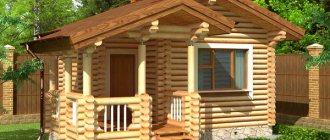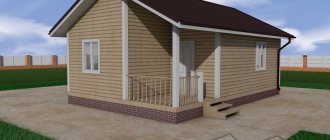Ask yourself a question: how will the board dry in such conditions? The correct answer is very bad. There is no ventilation inside the wall, there is nowhere for moisture to escape, creating ideal conditions for the development of mold, mildew and rot. But you may not see this, since everything will already be sewn up.
Yes, you can treat wood with antiseptics. But firstly, the efficiency of processing wet wood is very low, the board is damp and does not “absorb” the antiseptic. Secondly, the most effective antiseptic method is impregnation, that is, pressure impregnation, when the composition penetrates deep into the wood, is impossible in the field, and treatment with a brush or other surface method does not give such a strong effect, affecting only the top layer of the board.
And finally, antiseptic treatment costs money. Which again we add to the cost of the board.
Let's sum it up on the natural humidity board
So you pay inexpensively for the material itself, but you may end up with a crooked, cracked, moldy frame. And it’s not a fact that you will see it. If the house is done quickly and “handed over,” then you will not see any mold or cracks. But you will feel the cracks by how the house will lose heat, and a moldy frame will shorten the life of the house.
Therefore, in my opinion, the only acceptable option for building a frame from a board of natural moisture is to install the frame and leave it for 1-2 months to “dry” with good ventilation. With further struggle with cracks and possible geometry violations.
Also, I usually give an example of one story I read on the forums.
The customer decided to build a house from boards of natural moisture, because dry ones seemed too expensive for her. As a result, at first she spent about 40,000 rubles on treating the entire frame with antiseptics (which already eliminated the difference with a dry board), then, when it came to finishing, she had to install another metal frame under the gypsum board, since it was not possible to mount the gypsum board on curved walls .
Do you think she saved money in the end or not?
I’m not saying that it’s absolutely forbidden to build with boards of natural moisture. But when choosing such a board, you need to be aware of the possible consequences and the fact that the initial cheapness can be more than “covered” by correcting the problems that have arisen.
And by the way, personally, if there is a question of saving, I have nothing against using boards with natural humidity in places where there are no high requirements for the size and geometry of the board and there are conditions for its drying. As a rule, these are various battens on which boards up to 25mm thick are used. This board dries quickly enough and does not change its size that much during the drying process. And the volume of boards used for sheathing can be quite significant.
Board dimensions
So, we go to the nearest large construction market, having previously purchased a tape measure and calipers. We ask how much an edged board with a section of 150-200 x 40-50 mm costs. 5000-6000 rubles per cubic meter is the average price. Great, we need 20 cubic meters of timber for the frame, and we will spend about 100,000 rubles on the frame skeleton of a 2-story house, with some left over for the roof. That's why everyone thinks that a frame house is inexpensive.
Let's now take a closer look at these boards; to do this, we measure 6-meter boards with a tape measure, the length of which turns out to be in the range from 5.80 m to 6.10 m. The edges are cut poorly, so when trimming we will lose another 5-10 cm. If you have 3 -x meter ceilings, then a quarter of the racks (2.70-2.90 m) will be used as trimmings.
We check the thickness and width with a caliper. For example, for a board thickness of 50 mm declared by a dealer, you will find boards in one stack whose length range is 37...52 mm. For a board thickness of 150 mm, the range will range from 130 mm to 153 mm.
An experienced builder with 30 years of experience will say: “So what? At a construction site they measure cm, not mm. This is within the tolerances.” Yes, but such tolerances in a frame house will lead to this: you lay the bottom frame of such boards on a level foundation and you get an uneven floor and base for the walls. And errors will accumulate with each floor.
That is why in America and Northern Europe no one would think of building a frame house from ordinary edged boards.
Wooden barn frame
The frame of the barn is erected with your own hands without the use of special equipment. It is easy to assemble using construction tools.
To build a shed frame from a board, you will need material whose size is 100x50 mm. Construction begins only after the foundation has completely hardened, if the structure is placed on a support. The first thing they do is assemble the bottom frame of the barn from 100x100 mm timber. with your own hands. Next, the boards are used to make floor logs. The pitch between the material should be 500-600 mm. Then the vertical posts are fixed.
On a note
The boards are fixed around the entire perimeter at a distance of 500-600 mm. between themselves. To strengthen the structure, jibs are attached to the corners. After this, the top trim of the barn is performed.
Actual cost
The second obvious disadvantage of buying edged boards on the market is the conditions into which the buyer is forced. Regular edged boards are sold individually on the basis that:
1) edged board with dimensions 50 mm x 100 mm x 6,000 mm: 33 boards per 1 m3;
2) edged board with dimensions 50 mm x 150 mm x 6,000 mm: 22 boards per 1 m3;
3) edged board with dimensions 50 mm x 200 mm x 6,000 mm: 16 boards per 1 m3;
4) edged board with dimensions 50 mm x 250 mm x 6,000 mm: 13 boards per 1 m3;
5) edged board with dimensions 50 mm x 300 mm x 6,000 mm: 11 boards per 1 m3;
5) edged board with dimensions 25 mm x 100 mm x 6,000 mm: 66 boards per 1 m3;
6) edged board with dimensions 25 mm x 150 mm x 6,000 mm: 44 boards per 1 m3;
7) edged board (bar) with dimensions 50 mm x 50 mm x 3,000 mm: 133 pieces per 1 m3;
 edged board (bar) with dimensions 40 mm x 50 mm x 3,000 mm: 166 pieces per 1 m3;
edged board (bar) with dimensions 40 mm x 50 mm x 3,000 mm: 166 pieces per 1 m3;
9) edged board (bar) with dimensions 40 mm x 40 mm x 3,000 mm: 208 pieces per 1 m3.
All fractional parts are rounded to a natural number, not in your favor.
In fact, you buy a board with a cross-section of 46 mm x 142 mm x 5,850 mm - 26 boards 1 m3, but you get 22 boards, which is 18% less. In this case, your project was created for a board with a cross-section of 50 mm x 150 mm; it will have to be changed according to the actual dimensions directly at the construction site.
When you buy a planed board, you pay for the actual dimensions, for example, 38 mm x 140 mm x 6,000 mm (31.32 boards per 1 m3); when you buy an edged board at a nearby market, you pay the extra money into the pocket of a cunning seller.
Foundation
The frame for the shed is light in weight, as is the entire structure itself. For this reason, it is recommended to use a columnar foundation as a support for the structure. Even a non-professional can arrange it on his own.
Support columns are installed in the corners of the structure and where the partitions will be bridged. The distance between the posts should not exceed 2 meters. Supports are also erected in the center of a small wall if its length exceeds 2.5 m. This will protect the floor from sagging during walking.
Foundation for a frame shed.
Step-by-step instructions for constructing a columnar foundation:
- Dig holes 800 mm deep.
- Fill the holes with sand, crushed stone or gravel to 150 mm. and compact the materials.
- Carry out the masonry using cinder blocks or red bricks, as well as concrete mortar.
Once the foundation is dry, you can begin building the shed frame.
Humidity of boards
Pay attention to the edged board in the photo above: this is a regular edged board of natural moisture with a cross-section of 50 x 100 mm. At the time of purchase it was an ordinary flat board. During natural drying in a stack, it lay in the top rows, and as a result it was deformed in two planes at once. Such boards may look decent at the time of purchase; you will even have time to build a frame house from it, but then, while drying, it will begin to “twist”. The board must reach a humidity of 12-16% before construction begins. Otherwise, you will get a typical frame-and-slot house with all the delights in the form of blown walls and cracked drywall. The board used to build a frame house must be dried without deformation in the chamber. The drying process takes several days. For this purpose, heating, blowing, vacuum, etc. are used. The main task is to “take away” excess moisture from the wood and minimize the deformation of the boards during drying.
Frame barn
Before you start building a shed, you must first choose a site for the building. It is recommended to erect a building where there are no plans to develop beds for planting agricultural crops. At the same time, the distance of the barn from the house is not important and you can be guided by personal preferences. A wooden shed is suitable for construction both near the house and at a distance from it.
Place for a shed near the fence.
Board defects
Wood is a natural material. It is impossible to ensure that the boards are ideal along the axes and with dimensional accuracy of tenths of a mm. But on the other hand, the construction of a frame house is not a furniture factory, and a carpenter is not a joiner. Boards, even kiln-dried and planed, may have slight defects. For example, have the shape of a “bowl” or “saber”. The main question is how pronounced these defects are. You can use “small sabers” for small-sized frame racks under windows, and the spacers and “bowls” will be used as jibs. When choosing and purchasing boards for a frame house, pay attention to the number of defective boards. To do this, it is necessary to take an active part in loading or unloading goods. The cunning of market traders usually manifests itself in two ways: You are offered to load the boards by local Tajiks, who are instructed to work quickly and load everything. In this case, it is very difficult to control the quality of the boards. The second method is the absence of choice, that is, the trader keeps a couple of cubes on the site, thereby the selection of boards is only indicated, since there is nothing to choose from. You are forced to accept a decent amount of boards with defects, because otherwise you will have to swear and unload the machine back. And it is not at all obvious that the neighboring merchant will want to sell you only the best boards and keep the crooked ones with wane.
Americans are quite relaxed about “light sabers” and actively use them for rafter systems, frame house posts, and interfloor joists. For rafters and joists, it is recommended to place the boards with the saber facing up so that the load from above can straighten them along their axis. For frame racks of external and internal walls, it is necessary to place the sabers in one direction. In this case, you can trim off the excess, or use plywood overlays to level the base for the drywall.
Do-it-yourself change house - how to do it right
The construction of such a small structure is practically no different from the construction of permanent buildings and involves several stages:
- project selection;
- preparation of necessary materials;
- foundation device;
- assembly of wall frames and internal partitions;
- installation of doors and windows;
- roofing;
- insulation device;
- covering the external and internal surfaces of walls.
Materials
For such a small house, the main material will be 50x50 mm timber.
It will be used to construct the building frame, the frame of internal partitions and the rafter system. For cladding the outer surface, it is recommended to use a block house or wooden lining of appropriate length.
It is recommended to cover the internal surfaces with panel materials, on top of which you can install cladding from various types of lining or block house to imitate a log house.
It is recommended to use metal tiles, sheet metal or corrugated sheets as roofing materials. Roll roofing materials, although they have excellent properties, but with a small roof slope such materials will last much less. In addition, the use of metal materials will make it possible to extend the roof by 10-15 cm, thereby ensuring the drainage of rainwater from hitting the walls.
For fastening work, it is better to choose standard fasteners that provide sufficiently strong fastening of parts and the ability to use the same type of elements in different places in the structure. There is no great need to use home-made elements in this case - it is irrational both from the point of view of the time spent on their production and the gain, from an economic point of view.
Time to buy
It is believed that the best quality is winter wood, that is, boards sawn from wood harvested in winter. At this moment, the movement of juices (moisture) through the wood is minimal, so boards from winter wood are stronger and less deformed. Many builders prefer to buy timber in winter and arrange stacks for atmospheric drying. The idea is good, however, 2 questions immediately arise: how to protect yourself from the fact that the boards can be stolen; how to protect the boards of the upper rows, which are not fixed by the load of the overlying boards, from deformation. If you ask market traders at any time of the year what kind of wood the boards are cut from, you will get a clear answer: “From winter wood.” Even in September they told me that in the winter we bring in logs and cut them as needed. On the left in the photo is a damp log cut down in the summer.
The demand on the building materials market in our country is so high that during the high construction season, boards from winter wood are finished by June. Timber industry enterprises and black loggers continue to fell trees all year round. Having bought a board from a winter forest at a nearby market, you are surprised to notice that it weighs twice as much as usual, a circular saw gets stuck in it, after 3 days of storage it was twisted into a spiral and black spots of mold appeared. These are signs of damp, freshly cut wood. The Americans call them green lumber, and according to their construction requirements, you can use such boards to light a fire in a barbecue. The main problem of a summer forest is the increased moisture content with all that it implies and insufficient strength for the construction of a frame house. A reasonable question: can such boards be used to build a frame house?
It is possible if you meet 2 conditions: the board must be dried in a chamber and the board must be made from mature (old) forest, and not young pine or spruce. In order to distinguish a mature forest from a young one, pay attention to the width of the rings on the cut. Young wood has wider annual rings. The best thing to do is come to the sawmill and look at these logs. An order of 20-25 m3 of timber is a decent amount for any seller, so he will be ready to invite you to production and answer any questions you may have.
Is it worth it or not to build it yourself? Expert opinion
The question to build or not to build, although it is reminiscent of Hamlet’s “To be or not to be?” in many respects can be decided after studying the opinions of experts, where you can conditionally attract both truly professionals and those who can boast of a self-built change house.
For those who already have experience in assembling such buildings and can share their own experience, both positive and, alas, not entirely, I will assure you that this is quite possible and even needs to be done, well, at least in order to believe in your abilities.
The truth lies somewhere in the middle. For a person who has a clear work plan, knows how to handle basic tools, or at least hold a hammer in his hands, this is quite possible. For those who think that this is irrational, it will be quite normal to buy a ready-made project.
What are the consequences of self-construction? Builder mistakes
When constructing a summer cottage yourself, you must take into account:
- documentation of construction, this is relevant for all types of buildings, both on the land of gardening partnerships and other lands, because the structure does not hang in the air;
- the presence of a project, even the simplest one, but with minimal calculations of materials, it can be corrected at any time, but without calculations the material will have to be constantly purchased;
- the project must take into account the power of the electrical wiring, the placement of heating devices, and support systems, and this should be done primarily by professionals, since incorrect calculation of the cable cross-section can lead to a short circuit in the wiring and a fire.
But professional builders, as a rule, make the following mistakes:
- incorrect placement of the building;
- violation of construction technology;
- poor quality of various operations and works;
Board storage
It may take several months from the moment you purchase the boards until they are used. They must be stored in a stack, protected from rain and snow from above, dirt and water from below, and blown by all winds from the side. Rows of boards are laid through spacers, which provides access to fresh air from all sides and minimizes the risk of fungus developing on the surface of the boards. If the boards upon purchase have an unhealthy gray appearance, black spots are visible on the surface, it is better to refuse such a purchase, since the wood was stored incorrectly. The fungus can theoretically be bleached with bleach, scraped off and trimmed off, but why do you need these problems?
A good seller stores timber in normal, ventilated stacks. Although very often you can see stacks of edged boards on construction markets without gaskets or protection from rain. The process of rotting of the boards has already begun and they will finally acquire a black-gray color at your construction site after purchase. You can store boards in stacks without spacers only if the boards have been processed in a drying chamber. You can store the board in this way for a short time, since rainwater getting into the stack will lead to the appearance of black mold on the boards.
Barn frame made of timber
Most often, the frame of a barn is made of timber. To construct the structure, you will need dry material that is free from defects, mold and mildew. The recommended timber size is 100x100 mm. Before erecting the structure, it is recommended to treat the material with an antiseptic agent to protect it from the harmful effects of an aggressive biological environment, as well as a fire retardant, which will prevent the structure from catching fire.
Timber frame shed.
To build a barn frame from timber, professionals advise taking material whose length corresponds to the size of the large wall of the structure. This will allow you to make the strapping from one piece of material, rather than assembling it from parts.
Fungus and mold.
Wood is affected by fungus if you have created “favorable” conditions for this: high humidity + poor ventilation. Black mold spores can be found even on healthy, freshly cut wood, but its growth occurs only in suitable conditions. Within a few days, the boards become covered with black spots that can still be scraped off. But if the process of fungal development goes further, then the mold affects the entire depth of the board.
You can bleach surface damage with a chlorine solution and trim it off. You cannot remove deep mold. What is the danger of boards covered with black mold? Fungal spores can cause allergic reactions in people living in contact with such wood. Boards affected by mold lose strength and are capable of infecting neighboring healthy boards if “favorable” conditions are created for this (humidity and lack of ventilation). You can use boards slightly touched by black mold to build a frame house if you treat them with bleach, plan them and cover them with an antiseptic. If the depth of fungus damage to the boards is considerable, then such boards cannot be purchased, much less used for the construction of a frame house.
The presence of white mold is a sign of rotten wood. Such a board is unsuitable for building a frame house.
Methods for constructing a wooden base
The construction of the frame can occur in different ways. Some people assemble the walls one by one on the ground, and only then install them vertically.
Others immediately install a wall frame, then insulate it, insulate it and sheath it. Still others make the frame of the entire building, including the roof, and only after that they begin to make layers of walls.
You can choose any method convenient for you, but for now we will focus only on the construction of the frame.
House frame with roof
The basis of any frame building is wood. Her choice must be approached with full responsibility.
This can be a board, technically dried timber, natural moisture timber or laminated veneer lumber.
Glued laminated timber is the most preferable - it does not dry out, does not lose its shape, and is resistant to deformation. In second place is technical drying timber.
And a natural board or timber with natural moisture during the construction of a frame can change its shape and crack when it dries, which will affect the quality of housing.
Do not forget to treat all wooden elements of the frame with impregnations - fire and bioprotection. This will protect your frame from bugs and make your home safer.
Complex frame elements
Various types of wood are suitable for a frame house, but it is better to stick to coniferous wood.
The resin secreted by pine creates additional protection against insects and fills the house itself with a pleasant pine aroma.
In addition, oak, ash and other hard varieties are excellent for installing frames. The section of the timber should be 150/150 mm or 150/200 mm.
Presence of natural wood defects
Knots, bark residues (wane), and resin pockets reduce the quality of the boards, and hence the price. All these defects directly affect the strength of such boards, so even by removing the bark, peeling out the knots and emptying the resin pockets, you can use such boards in those parts of the frame house that do not bear a significant structural load. For example, frame racks of non-load-bearing walls. To assess the quality of wood in Russia, the GOST system is in force. However, when buying a board on the market, you will not be able to receive a quality certificate unless it is a board manufactured for export.
States have their own quality assessment system, according to which boards are assigned grades 1-4. For the construction of frame houses, boards of the 1st and 2nd classes are usually used, that is, the number of natural wood defects is minimal.
What nails should I use in a frame house?
Everywhere in the main power frame. We use 90mm long nails.
The reason is that the American and Canadian standards are the same, however, the length and cross-section there are slightly different. And they say nails are at least 82 mm, but usually an 89 mm nail is used. By American standards this is size D16. Therefore, our closest suitable option is 90mm.
It is required to install the fastening using 1 nail for every 51mm length of the board, therefore, for a 150mm board, 3 nails will be needed per fastening point with an end, for a 200mm board, 4 nails, respectively.
We do not invent a bicycle and do not make 2 nails of 100 or even 120 mm.
The type of nails does not really matter: simple smooth, screw or threaded, these are just modern options that are convenient in their cases.
Tree age
The age of the tree from which the board is made is determined by the number of annual rings. Small, frequent rings are signs of a mature tree, wide and light - signs of young green wood. Pay attention to the photo below. The top board is made of 8-year-old pine. The age of the wood on the bottom board is 57 years.
Age affects the strength of wood. Therefore, when you choose edged boards for building a frame house, pay attention to the end parts of the boards in the stack. Boards made from mature wood are best used for load-bearing structures and floor joists. Such boards should not be cut into small pieces for window mullions or fire bracing. For this purpose, you can use boards from young “green” wood.
Board for floor joists and floor joists
Depending on the size of the joist span, two main sections of the board are used for floor joists: 150x50mm (40) and 200x50mm (40). I used 50 mm boards because... The difference in itself is small, but still with such a board you will feel safer about the floor under your feet.
Standard sections of boards for standard spans with standard lag pitch : Span 2-3 meters: 150×50mm. Span 3-4 meters: 200×50mm. A span of more than 4 meters is already 50x250mm. For spans of more than 5 meters, a separate calculation is required. A handy calculator is here.
Cutting method
Boards made from the same log may have different technical characteristics, which directly depend on what part of the tree the board is made from and in what direction the cut was made. The strongest part of the tree is located closer to the center. The outer layers in a living tree are responsible for delivering nutrients to the branches, so they are inferior in terms of strength and moisture content to the core. That is why the most durable boards and joists should be chosen from wood close to the center.
The strength parameters are also affected by the direction of the cut: radial or tangential. The radial-sized board contains parts of the core and the softer outer part. Usually only weak wood from the outer part is cut into a tangential cut, since the core is used to make high-quality timber. An intermediate option No. 3 in the figure below is also possible, which is something between radial No. 1 and dance No. 2 cuts.
Radial cut boards are preferable to those sawn from the outer layers, as they are less deformed during drying.
I hope that a small educational program will help you, at least, not to approach the choice of boards for building a frame house at random and with childish gullibility towards hardened sellers on the construction market. In addition to the above parameters, there are a dozen more requirements that experts place on edged boards, but many of them are of little use to a private buyer. For example, almost 100% of edged boards on Russian markets are pine or spruce. In America, each type of pine is described in detail according to dozens of parameters, which are included in the form of large tables in the thousand-page Building Codes (Codes). In Russia, at best, you can find out in which region the tree from which these edged boards were made was cut down. However, using simple rules and your powers of observation, you can choose a decent board from which to build your frame house.
Do you need a drawing to build a frame shed?
A frame utility block is a light and simple building that people will only enter occasionally. Therefore, as a rule, a real professional project for the construction of a shed is not ordered. But this does not mean that you can do without drawings altogether.
It is imperative to make a drawing of the future barn in two projections: from the side and from the front. They must indicate:
- width, height, length of the barn;
- roof slope;
- location of the doorway;
- rafters, vertical frame posts and horizontal bars;
- depth for a strip foundation and the number of pillars for a columnar foundation.
The drawing does not have to be made according to all the rules - it can be made schematic. The main thing is that you can build a frame shed according to it.
Conclusion
The frame for plasterboard made of wood is not an invention of builders. This technology is described in the manufacturers' technology sheets, although not in as much detail as the frames on the profiles.
©gipsokart.ru
More articles
- Tall plasterboard partitions
- How to make a doorway in a plasterboard partition
- Interior partition made of plasterboard with a door
- Installation of a plasterboard partition
- General information about plasterboard partitions
- DIY plasterboard partition
- Partition made of two layers of plasterboard: technology of covering 2 layers of plasterboard
- Rules for installing plasterboard partitions
- Profile for plasterboard partitions
- Calculation of a plasterboard partition
What are the risks of using a wet board?
The frame wall is sealed on both sides with films. The moisture that was in the board at that moment remains in the wall FOREVER. This immediately leads to the formation of mold.
Never mind the accuracy and the cracks that will appear when it dries. This is being resolved. The biggest problem is mold.
Rotting of boards and their destruction is the number one danger. This video clearly shows the consequences.
The main problem is black mold. These are not just some health problems. This is a danger to life.
I heard from one grandfather: “If black mold appears in the house, you cannot get rid of it. Just burn it down and build a new one"
“In 100% of cases, oncology is diagnosed along with the presence of black mold in the body”
My doctor of bioresonance diagnostics
From my own experience, I know that it’s unknown where a child’s allergies or asthma come from; constant sick leave can be due to mold. You may not be aware of its existence in the wall for years.
Now that we know the enemy by sight, we can move on to solutions.
Why do all builders drown for dry boards?
Because she is like air to them. Saves time, which for them is money:
- Ideal sizes mean saving time. There is no need to align or adjust anything. Everything is immediately ideal.
- We quickly assemble the frame, insulate it, cover it and run to the next object. This won't work with moisture. More on this below.
- The supplier gives a discounted price. Nothing prevents the company from showing you this discount and earning an extra 20-30,000 rubles. One step at a time, as they say.
- If a company gives a guarantee on a house, then it doesn’t want to take risks and sort out problems later at its own expense.
Professionals have a main argument. And they are 100% right. A dry calibrated board keeps all joints as tight and strong as they were when assembling the frame. When wet, when dry, it will give gaps of 1,2,3 mm where there were none during assembly.

